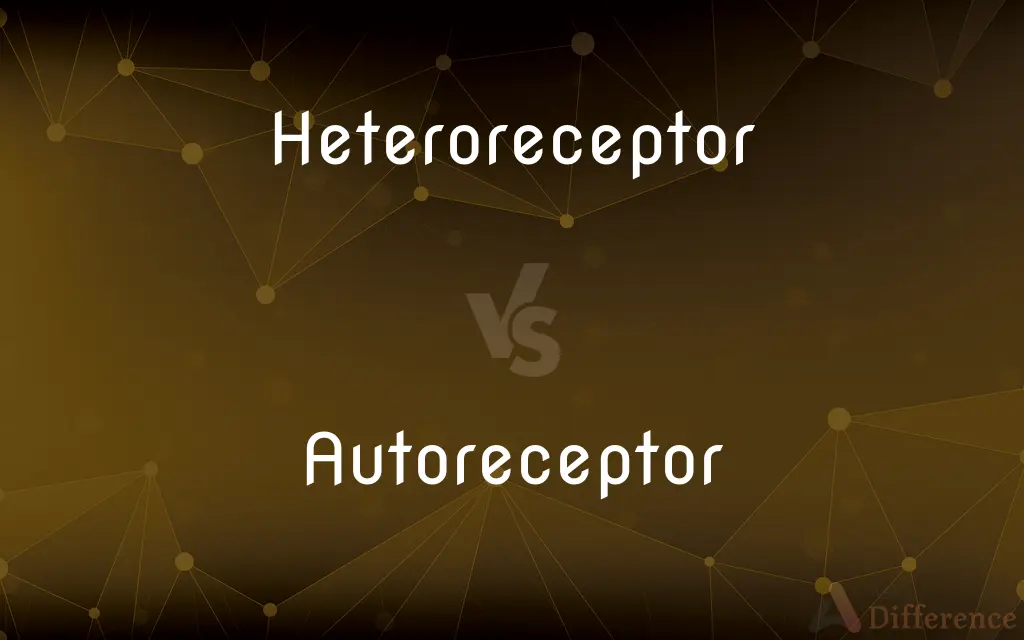Heteroreceptor vs. Autoreceptor — What's the Difference?
By Tayyaba Rehman & Maham Liaqat — Updated on March 19, 2024
Heteroreceptors modulate neurotransmitter release from neurons they're not responsive to, while autoreceptors regulate their own neurotransmitter's release.

Difference Between Heteroreceptor and Autoreceptor
Table of Contents
ADVERTISEMENT
Key Differences
Heteroreceptors are found on the postsynaptic membrane, where they respond to neurotransmitters or modulators different from those released by the neuron itself. On the other hand, autoreceptors are located on the presynaptic membrane of a neuron and are sensitive to the neurotransmitter released by the neuron itself.
Heteroreceptors are often involved in complex signaling pathways, allowing for the modulation of neurotransmission in response to a variety of external and internal stimuli. This capacity enables the nervous system to adapt its response based on different physiological states or environmental conditions. Autoreceptors, in contrast, provide a more direct form of feedback control, limiting or enhancing neurotransmitter release based on the concentration of neurotransmitter in the synaptic cleft. This helps prevent overstimulation or understimulation of the postsynaptic neuron.
The interaction with pharmaceuticals can differ significantly between heteroreceptors and autoreceptors. Drugs targeting heteroreceptors can modulate the effects of one neurotransmitter on a neuron that releases a different neurotransmitter, offering potential for therapeutic interventions in cases of neurotransmitter imbalance. Whereas drugs affecting autoreceptors directly influence the release of the neurotransmitter that the neuron produces, which can be crucial in treating disorders related to neurotransmitter overproduction or deficiency.
Heteroreceptors allow for a level of signaling complexity and integration across different neurotransmitter systems, contributing to the neural plasticity and versatility of the nervous system. This integration is key to processes such as learning, memory, and adaptation to stress. Conversely, autoreceptors play a fundamental role in maintaining synaptic efficiency and preventing neuronal overactivity, essential for the stable operation of neural circuits and for preventing excitotoxicity.
While heteroreceptors and autoreceptors both contribute to the regulation of neurotransmission, their mechanisms of action and physiological roles differ markedly, reflecting the complexity and adaptability of the nervous system in processing information and maintaining homeostasis.
ADVERTISEMENT
Comparison Chart
Location
Postsynaptic membrane
Presynaptic membrane
Function
Modulates neurotransmission from different neurons
Regulates own neurotransmitter's release
Feedback Mechanism
Indirect, through modulation of different systems
Direct, through self-regulation
Role in Plasticity
Facilitates complex signaling and integration
Maintains synaptic efficiency and prevents overactivity
Pharmaceutical Target
Potential for broader therapeutic interventions
Direct influence on neurotransmitter release
Compare with Definitions
Heteroreceptor
Plays a key role in neural plasticity and adaptability.
Heteroreceptors are involved in learning by modulating neurotransmitter effects.
Autoreceptor
Directly influences synaptic strength and efficiency.
Autoreceptors adjusting neurotransmitter release help maintain synaptic homeostasis.
Heteroreceptor
Found primarily on the postsynaptic membrane, influencing neurotransmission indirectly.
Heteroreceptors can enhance or inhibit the action of the primary neurotransmitter.
Autoreceptor
A receptor located on the presynaptic neuron, sensitive to the neuron's own neurotransmitter.
A dopamine autoreceptor regulates dopamine release from the neuron.
Heteroreceptor
Involved in complex signaling pathways.
Heteroreceptors on GABAergic neurons can respond to glutamate to modulate inhibitory signals.
Autoreceptor
Targeted by drugs to control neurotransmitter levels.
Drugs targeting autoreceptors can treat conditions related to neurotransmitter excess.
Heteroreceptor
A receptor that responds to neurotransmitters different from those released by the neuron it is located on.
A dopamine heteroreceptor on a serotonin neuron modulates serotonin release in response to dopamine.
Autoreceptor
Essential for preventing overstimulation of the postsynaptic neuron.
Autoreceptors prevent excitotoxicity by limiting neurotransmitter release.
Heteroreceptor
Can be targeted by drugs to modify the effects of neurotransmitters.
Certain antidepressants work by acting on serotonin heteroreceptors on dopamine neurons.
Autoreceptor
Serves as a feedback mechanism for neurotransmitter release.
Autoreceptors inhibit further neurotransmitter release when levels are high.
Heteroreceptor
A heteroreceptor is a receptor regulating the synthesis and/or the release of mediators other than its own ligand.Heteroreceptors respond to neurotransmitters, neuromodulators, or neurohormones released from adjacent neurons or cells; they are opposite to autoreceptors, which are sensitive only to neurotransmitters or hormones released by the cell in whose wall they are embedded.
Autoreceptor
An autoreceptor is a type of receptor located in the membranes of presynaptic nerve cells. It serves as part of a negative feedback loop in signal transduction.
Heteroreceptor
(biochemistry) A receptor regulating the synthesis and/or release of mediators other than its own ligand.
Autoreceptor
A receptor, situated in the terminal of a presynaptic nerve cell, that is sensitive to neurotransmitters released by the neuron in whose membrane the autoreceptor sits.
Common Curiosities
How do heteroreceptors function?
Heteroreceptors modulate the effects of neurotransmitters from other neurons, influencing various physiological processes and neural plasticity.
Where are heteroreceptors located?
Heteroreceptors are primarily located on the postsynaptic membrane of neurons.
What is an autoreceptor?
An autoreceptor is a type of receptor located on the presynaptic side of a neuron, sensitive to the neurotransmitter that the neuron itself releases.
How do autoreceptors contribute to neural function?
Autoreceptors maintain synaptic efficiency and prevent overactivity, ensuring stable neural circuit operation.
Can drugs target heteroreceptors and autoreceptors?
Yes, drugs can target both heteroreceptors and autoreceptors to modulate neurotransmitter levels and activity for therapeutic purposes.
Are heteroreceptors involved in learning and memory?
Yes, heteroreceptors contribute to learning and memory by facilitating neurotransmitter modulation and neural plasticity.
Where are autoreceptors located?
Autoreceptors are found on the presynaptic membrane of neurons.
What role do heteroreceptors play in the nervous system?
Heteroreceptors facilitate complex signaling and integration across different neurotransmitter systems, contributing to neural plasticity and adaptability.
What is a heteroreceptor?
A heteroreceptor is a type of receptor located on a neuron that responds to neurotransmitters or modulators different from those the neuron itself releases.
How do autoreceptors prevent excitotoxicity?
Autoreceptors limit neurotransmitter release, preventing overstimulation of the postsynaptic neuron and protecting against excitotoxicity.
What makes heteroreceptors and autoreceptors different in terms of feedback mechanism?
Heteroreceptors provide indirect modulation of neurotransmission across different systems, while autoreceptors offer a direct form of feedback control by regulating their own neurotransmitter's release.
How do autoreceptors function?
Autoreceptors regulate the release of their own neurotransmitter, serving as a feedback mechanism to maintain synaptic homeostasis.
Why are heteroreceptors important for pharmaceutical interventions?
Heteroreceptors can be targeted by drugs to modulate the effects of neurotransmitters on neurons that release different neurotransmitters, offering potential for treating neurotransmitter imbalances.
What is the difference between a heteroreceptor and an autoreceptor?
The main difference is that heteroreceptors respond to different neurotransmitters than those the neuron releases, while autoreceptors are sensitive to the neuron's own neurotransmitter.
Can targeting autoreceptors treat neurotransmitter-related disorders?
Targeting autoreceptors with drugs can help manage disorders related to neurotransmitter overproduction or deficiency by regulating neurotransmitter release.
Share Your Discovery

Previous Comparison
Urn vs. Vase
Next Comparison
Discourse vs. SyntaxAuthor Spotlight
Written by
Tayyaba RehmanTayyaba Rehman is a distinguished writer, currently serving as a primary contributor to askdifference.com. As a researcher in semantics and etymology, Tayyaba's passion for the complexity of languages and their distinctions has found a perfect home on the platform. Tayyaba delves into the intricacies of language, distinguishing between commonly confused words and phrases, thereby providing clarity for readers worldwide.
Co-written by
Maham Liaqat















































